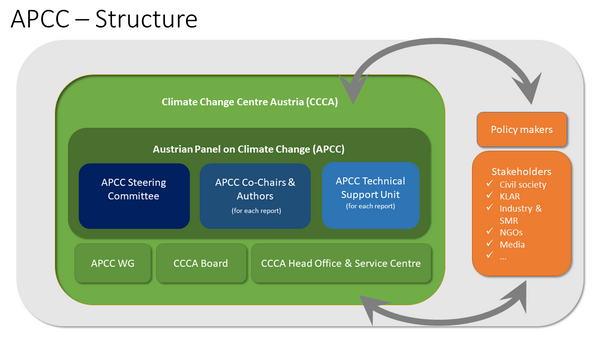APCC Products
APCC products serve to assess, summarise, and evaluate the current state of science and research on clearly defined topics (Special Report) or on climate change in general (Progress Reports). With regard to knowledge requirements in specific fields of practice, the topic proposals are drawn up and proposed to potential financing partners in agreement between the APCC WG, the CCCA Board, and the APCC Steering Committee (APCC SC). APCC products assess the current state of scientific knowledge and may also infer future research needs. Creating APCC products involves the entire Austrian scientific community concerned with the topic. The products have communicative character and are disseminated to a broad public upon completion. If necessary, sufficiently qualified and established international experts can be consulted when an APCC product is created. The Austrian Panel on Climate Change (APCC) itself does not carry out research projects, and APCC activities are not aimed at generating knowledge in the sense of disciplinary, interdisciplinary or transdisciplinary research. When in compliance with the APCC criteria, the following products can be generated as APCC products:
- Assessment Reports, i.e. comprehensive progress reports modelled on the AAR14, which present the Austria-related state of science and research on climate change (as defined by the CCCA) in a comprehensive and needs-oriented manner. Assessment Reports also contain Synthesis Reports. The latter must be both technically/scientifically relevant and of relevance to policymakers and the public (“technical summary”, “summary for policy makers”). Assessment Reports should be produced every seven to ten years.
- Special Reports on clearly defined topics. Special Reports go beyond the Progress Report, as they concentrate on a specific topic based on revised findings. They, too, contain a synthesis regarding the Report’s technical/scientific relevance and its relevance for policymakers and the public. Special Reports can, moreover, focus on more regional specifics. They should also be included in later issued Assessment Reports, although redundancies ought to be kept to a minimum.
APCC products address all decision makers and public opinion leaders in the fields of politics, economy, education, science, society at large, etc. They serve to advise policymakers at both federal and provincial levels as well as other relevant institutions such as chambers, associations etc.


